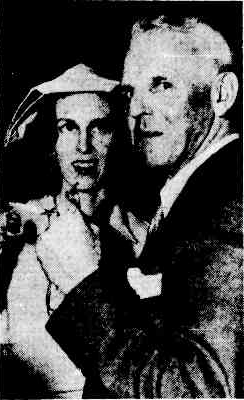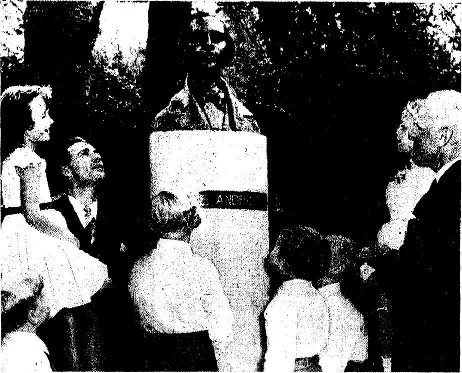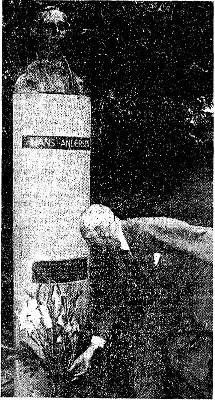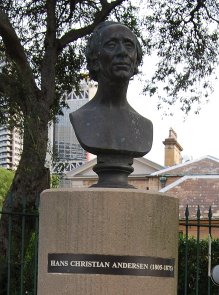I named this post knowing I may well get page hits from people trying to reach buttermyflapjacks.com, but it’s a danger I have to accept. I’m not talking about Pamela Anderson’s latest PR campaign, I’m talking about a statue of Hans Christian Andersen that stood in a public park in Australia in the 1950s. The bust was well-publicized, and was dedicated to the children of Sydney in a ceremony in the heart of the city. Some years later when workmen went to fetch the statue and move it to a different park, they discovered the statue was gone. To this day it has not been found, and no number of public appeals has been able to produce the missing statue.
Wendy Solling was the artist who sculpted the bust. She was born in New South Wales in 1926 to a doctor of Danish ancestry. She had wanted to follow her father into medicine, but being of the female persuasion she was dissuaded from a medical career. Instead she took up sculpture. She studied in Sydney and moved to London after she graduated. Sydney in those days was not kind to artists, as you will soon find out. The first exhibition of Solling’s work in Australia was held in September 1952 in her absence. She returned to Australia in December that year and was greeted by a small fanfare. Solling had already been building her reputation. Over the next few years she was the toast of the Sydney art scene. An article from The Sydney Morning Herald uses some choice words to describe an exhibition of French art at the National Gallery in 1953 at which Solling was present.

Sydney’s Domain on Friday looking like Buckingham Palace lawns during a garden party with flocks of elegant women in airy-fairy summer clothes tripping across the grass … Special traffic police working full time … Curious crowds watching the stream of limousines deposit the hundreds — from the sleek Diplomatic Corps, the Consular Corps, society (high and low), businesswomen (snatching an hour or two from the office), to artists (well-known and conventionally clothed, to lesser known and as unconventional as all get-out)… . For THE day had arrived. Having survived a shipwreck and endless delays over several years, THE FRENCH PAINTINGS had reached town.
There is something delicious and very Australian about the journalist’s attitude towards the airy-fairy artsy types, “unconventional as all get-out”. The most charitable thing the Australian spectators had to say about the French nudes was “Rude, I call that” and “Who ever saw an emerald green woman anyway”. A photograph shows Solling at the reception wearing a paper hat and rubbing shoulders with F. Henning Hergel, the Consul-General for Denmark. Hergel must have liked the hat, because in 1955 he called upon Solling’s skills.
1955 marked Hans Christian Andersen’s 150th birthday. There is a statue of Hans Christian Andersen in every major city around the world. The Danes have apparently been tireless in donating them, and in 1955 Henning Hergel felt it was time for Sydney to receive one of its own. He commissioned Wendy Solling to sculpt the bust, which was dedicated on the 27th of October 1955 in Phillip Park and was received by the Lord Mayor.

I have only two photographs of the statue, both fuzzy newspaper scans. The first is from the original dedication of the statue in 1955. The second is from another article in 1963 when Henning Hergel visited Australia and stopped by the statue to lay some flowers at its base. The next time anyone cared to check on the statue, it was gone.

In 19651 the Danish consulate approached Sydney City Council to move the statue to a more prominent position in Wynyard Park. However, when they went to move the statue they discovered it had vanished off its plinth. Sigurd Sjoquist, one of the original Danish sponsors of the statue, said it was likely to have been taken for cleaning and lost along the way: “I believe it was mislaid during the renovations, it was put away in council storage and it could be anywhere.” The disappearing statue drew no attention at the time, but in 2005 the Danes launched more celebrations, this time for the 200th anniversary of Andersen’s birth, and they wanted the statue back.
In October 2004 the Hans Christian Andersen 2005 Foundation launched a search effort to track down the missing statue before the ceremony. They had less than a year to find it. They offered a holiday in Denmark as a reward for it, but by the time 2005 came rolling around there was still no sign of the statue. They commissioned a new statue in its place, a replica of an 1856 statue of Andersen from the National Museum of Denmark. On the 7th of March the new statue was unveiled on Observatory Hill by the Crown Prince and Crown Princess of Denmark.
Wendy Solling, the sculptor of the original statue in 1955, was not around to see this fanfare. In 1956, just one year after dedicating the sculpture of Hans Christian Andersen, Solling gave up professional art and moved to the UK to become Sister Angela in the order of St Clare of Assisi. Over the years Solling combined her religion and her sculpture, returning to Australia in 1975 and eventually moving to Massachussetts in 2000 to become an assistant priest at the Church of the Good Shepherd. She died of a stroke in 2002, and never got to see her statue of Andersen replaced.

The story of the missing bust would seem to have a neat ending. Solling had a long and active life, a new statue was commissioned to replace the lost one, and it was dedicated by none other than the Crown Prince and Princess of Denmark. Princess Mary, of course, is an Australian-born woman so the whole thing has a nice symmetry to it. But the fate of the statue was never resolved. Is it sitting in a council warehouse collecting dust? Or, as my fantasy has it, is the larger-than-life-size head sitting incongruously in someone’s living room next to a raven and a bust of Pallas and leering at the guests?
Notes
-
Some sources say 1984. I have not been able to distinguish which year for sure, but have preferred 1965 for this article because it appears to be given in a quote from the Danish consulate. ↩
Bibliography
-
Campbell, T.W. Religious Communities of the Anglican Communion — Australia, New Zealand and the South Pacific. ACT: T W Campbell, 2007. Web.
-
“French and German Diplomats Entertain”. The Sydney Morning Herald 1 March 1953: 30. Web.
-
“Hans Christian Andersen Statue Unveiled in City”. The Sydney Morning Herald 28 October 1955: 3. Web.
-
“Hunt is on for statue of Hans Christian Andersen”. Daily Times (Pakistan) 20 October 2004. Web.
-
“Media Release: City of Sydney”. AAP MediaNet Press Releases 22 February 2005. Web.
-
“Media Release: Hans Christian Andersen 2005 Foundation”. AAP MediaNet Press Releases 19 October 2004. Web.
-
“Social News: Gossip”. The Sydney Morning Herald 21 December 1952: 21. Web.
-
“Social News and Gossip”. The Sydney Morning Herald 19 October 1955: 9. Web.
-
“Tribute to a Storyteller”. The Sydney Morning Herald 10 April 1963: 17. Web.
-
Dictionary of Australian Artists Online. “Wendy Hope Solling”. Dictionary of Australian Artists Online. Web. 18 October 2010 <http://www.daao.org.au/main/read/5837>.